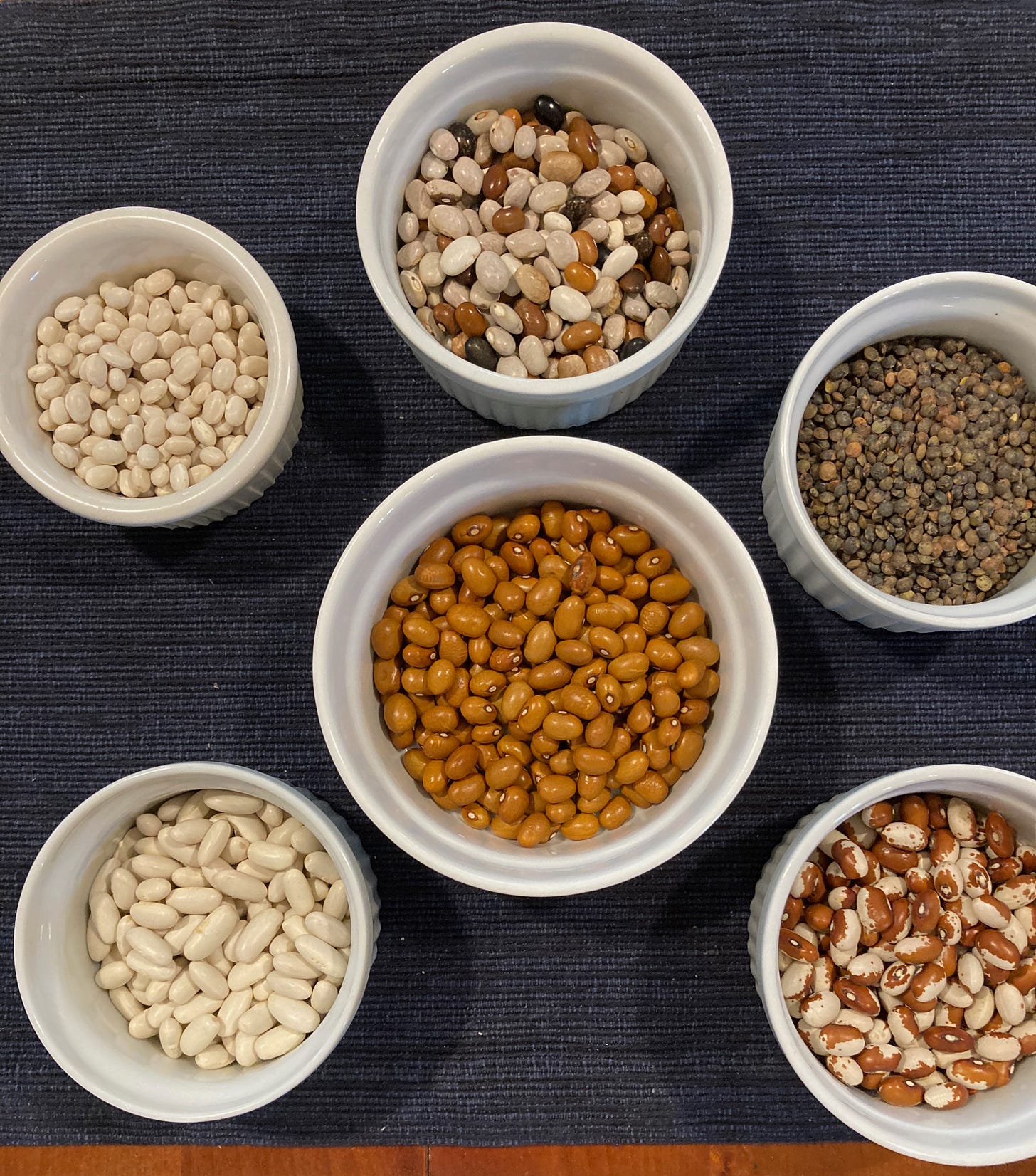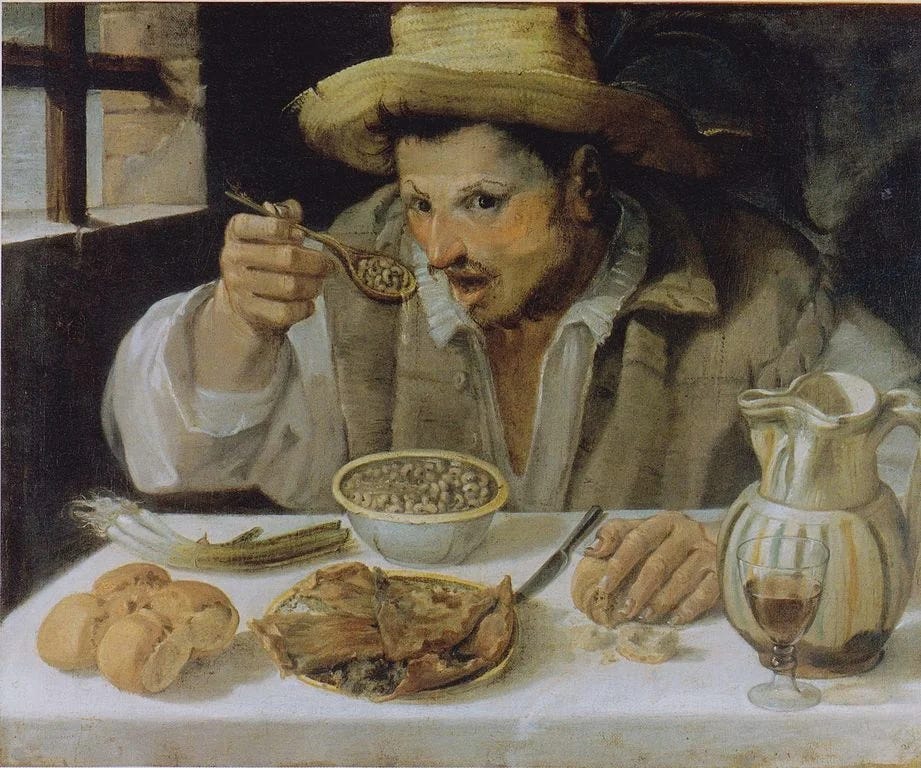BEANS
Plus recipes from Maine and Tuscany

These beans, representing but a small portion of what’s in my pantry, come, like most beans, with stories attached.
Marfax, with their deep golden color, are a New England favorite for baked beans, although in recent years they’ve become hard to find—we call them heirloom beans (but then, we could call most beans heirlooms, I think). These are available from Fedco Seeds, a Maine supplier of organic and open-pollinated seeds.
Otello’s pebbles are a mixture of unidentifiable beans, grown in Tuscany years ago by a farmer named Otello who was inordinately proud of his beans; I sent a sample to Ayer’s Creek Farm in Oregon where a skeptical Anthony Boutard grew them out, becoming convinced of their virtues when he saw the quality that emerged. As far as I know, they are only available through realgoodfood.com, the website of Jim Dixon’s Wellspent Market in Portland, Oregon (which has its own story, beginning in a garage in Portland some 25 or 30 years ago, expanding into a major supplier of high-class foods from around the world).
Small, dark lentils: I don’t remember where I got these but they look like the tiny lentils from the Piano Grande or Col Fiorito, high grassy plains in the heart of Umbria, protected by the soaring peaks of the Appenines, a treasured site for growing all kinds of prized Italian beans. gustiamo.com has many of them in its collection.
Yellow-eye beans: another Maine favorite for finest kind of baked beans, these are medium-sized with a dab of golden beige to distinguish them and cook up to a delightfully creamy texture. They’re available in many places but easy to find on the Rancho Gordo website and also at Fedco Seeds (see above).
Cannellini: the all-purpose Italian favorite white bean, used up and down the peninsula for any beany dish but especially treasured in bean-central Tuscany for everything from hearty ribollita (bean-and-bread soup) to a farmhouse staple with fresh pork sausages. These are easy to find but an exceptional variety is Rancho Gordo’s Marcella (see above), named for the goddess of Italian cooking.
Fagioli del purgatorio (Purgatory beans): This is a very special bean and I’m not sure you can find it outside of its Italian home near Viterbo’s Lago di Bolsena north of Rome. (At one point they were grown by Anthony Boutard at Ayers Creek Farm in Oregon, but he has retired from farming and I can’t find any evidence of their continued cultivation on this side of The Atlantic.) Because they’re very small and thin-skinned, they cook up quickly and, like lentils, don’t need to be soaked. The flavors are distinctive, beany yes, but delicately so. Italian chefs search for them, and I’ve searched for them on line to no avail. Make a note to pick them up next time you’re in Lazio or Umbria.
Not pictured but worthy of mention: sulfur beans, Jacob’s cattle (Anasazi) beans, soldier beans, and so many, many more.
Now, why am I waxing so eloquent about beans?
It all goes back to a post on Substack from my old friend Mitchell Davis, extolling the virtues of beans and legumes and describing a campaign to increase their consumption world-wide as one way to combat climate change. “Kitchen Sense” is the name of Mitchell’s Substack site and he talks very good sense here about a global campaign to double bean consumption by the year 2028. “Beans Is How” is the name of the campaign and you can find out more here at the Beans Is How website. Or read Mitchell’s inspiring prose on Kitchen Sense.
Yes, but why beans?
Why? For a variety of reasons, starting and ending with the fact that beans, properly cooked, are simply delicious. Properly cooked is the operative phrase but they are so easy to prepare that I wonder why beans are said to be difficult, even finicky. I also wonder at the hordes of respected food writers recommending canned beans. Canned beans, to my palate, taste of nothing so much as the tin that encloses them, no matter how thoroughly they’re rinsed. A can or two of chickpeas or navy beans is okay to stock the summer cabin or add to the sailor’s galley, but otherwise they have no purpose and not much flavor or texture. Every couple of weeks, I cook up a pound of beans of one kind or another so I always have some on hand, in the freezer or the fridge, to add to soups and salads, or just to bulk out a meal. It’s so easy and just makes good kitchen sense.
But it’s worth pointing out that, as well as being good to eat, beans are notably good for us, providing us with a natural source of proteins and fiber, and so low in calories and fat that we can feel quite comfortable adding a good glug of extra-virgin to our plates of beans. Depending on the recipe used, they’re vegetarian; indeed, as a protein source, they’re a must on any vegetarian or vegan table. Moreover, they’re cheap. Yes, you can find exotic and expensive beans on line but right now on Amazon I find dried beans as low as eight to fourteen cents an ounce (less than $2.50 a pound). That has to be the cheapest protein on the market by far.
And as if all those virtues aren’t enough, beans are also very good for the land. Wise farmers know that legumes are nitrogen-fixing, meaning they add more valuable nitrogen back to the soil than they extract from it. In Maine, as in many places, beans are rotated with grain crops, so one year it’s wheat or barley or corn, and the next year it’s marfax or yellow-eye or Jacob’s cattle beans.
Bean eaters
I’m lucky to count my principal homes in two parts of the world known for their beaniness. I mean of course Maine and Tuscany. Tuscans are actually called by other Italians mangiafagioli, or bean-eaters, and as for Maine, well, you can call them Boston baked beans if you insist, but you’ll have a hard time finding them outside the State of Maine where we know our beans. I sometimes think I grew up in the last family in Maine to eat beans religiously every Saturday night. Even in boarding school, over in the western mountains, we had beans for Saturday night supper and warmed-over beans for Sunday breakfast—along with popovers made fresh in the school kitchen, hot and crispy on the outside, custardy in the center, and a perfect foil for the humility of baked beans.
Nowadays I don’t make Maine baked beans quite so often. It’s hard to prepare a pot of beans for fewer than six or eight people and a lot of my friends are newcomers to our state who just don’t get the point. But if instead I invite them for a supper of Tuscan beans, they will flock to the table in appreciation. It all depends on how you craft your pitch. Or pitch your craft. With that in mind, I’ve given instructions below for both Maine baked beans and for the kind of Tuscan beans that form the basis for just about anything beany, from ribollita to pasta e fagioli (pasta fazool) to a fabulous zuppa di farro in which farro grains are finished in a properly thick and restorative bean soup, perfect for the chilly evenings of the olive harvest, which is coming up very soon.
Take a look at the Mediterranean Diet pyramid and you’ll find beans in a conspicuous place, among foods to be eaten daily. That’s doesn’t mean a heaping plate of beans once a day, but rather that beans are among the many vegetables that should play a prominent role in a healthy diet.
In the recipes that follow, I used yellow-eye beans for Maine baked beans and cannellini for the Tuscan beans but you can exchange them with just about any bean in your larder. One caution however: lentils cook up much more quickly than other legumes, which makes them ideal for a quick and healthy supper but not for long, slow cooking.
Shopping for beans is difficult only because it's hard to determine bean quality just by appearance. I buy beans on line from some of the sources mentioned above, or I buy from health-food and natural-food stores where the turnover tends to be higher than in ordinary supermarkets. The older the beans are, the longer they will take to cook and the longer they should soak before cooking. If you can be certain that the dried beans you’re using are from the current harvest, they may not need any soaking at all.
NB: A cup of dried beans soaked overnight should give you 2 to 2 ½ cups of soaked beans, which will cook up all on their own to a generous six servings with some left over for—well, for leftovers.
The following content is available only to paid subscribers. If you wish to read the whole post, including recipes, please take out a paid subscription. In that way, you’ll also be supporting my work, for which I am truly grateful.
Keep reading with a 7-day free trial
Subscribe to On the Kitchen Porch to keep reading this post and get 7 days of free access to the full post archives.


